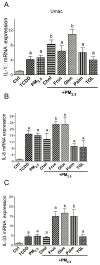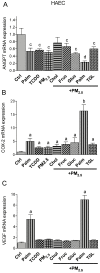AHR Signaling Interacting with Nutritional Factors Regulating the Expression of Markers in Vascular Inflammation and Atherogenesis
- PMID: 33167400
- PMCID: PMC7663825
- DOI: 10.3390/ijms21218287
AHR Signaling Interacting with Nutritional Factors Regulating the Expression of Markers in Vascular Inflammation and Atherogenesis
Abstract
There is strong evidence that exposure to fine particulate matter (PM2.5) and a high-fat diet (HFD) increase the risk of mortality from atherosclerotic cardiovascular diseases. Recent studies indicate that PM2.5 generated by combustion activates the Aryl Hydrocarbon Receptor (AHR) and inflammatory cytokines contributing to PM2.5-mediated atherogenesis. Here we investigate the effects of components of a HFD on PM-mediated activation of AHR in macrophages. Cells were treated with components of a HFD and AHR-activating PM and the expression of biomarkers of vascular inflammation was analyzed. The results show that glucose and triglyceride increase AHR-activity and PM2.5-mediated induction of cytochrome P450 (CYP)1A1 mRNA in macrophages. Cholesterol, fructose, and palmitic acid increased the PM- and AHR-mediated induction of proinflammatory cytokines in macrophages. Treatment with palmitic acid significantly increased the expression of inflammatory cytokines and markers of vascular injury in human aortic endothelial cells (HAEC) after treatment with PM2.5. The PM2.5-mediated activation of the atherogenic markers C-reactive protein (CRP) and S100A9, a damage-associated molecular pattern molecule, was found to be AHR-dependent and involved protein kinase A (PKA) and a CCAAT/enhancer-binding protein (C/EBP) binding element. This study identified nutritional factors interacting with AHR signaling and contributing to PM2.5-induced markers of atherogenesis and future cardiovascular risk.
Keywords: AHR; PM; TCDD; atherosclerosis; cytokines; inflammation; macrophages; obesity.
Conflict of interest statement
The authors declare no conflict of interest.
Figures








Similar articles
-
Ambient particulate matter activates the aryl hydrocarbon receptor in dendritic cells and enhances Th17 polarization.Toxicol Lett. 2018 Aug;292:85-96. doi: 10.1016/j.toxlet.2018.04.020. Epub 2018 Apr 22. Toxicol Lett. 2018. PMID: 29689377 Free PMC article.
-
Air particulate matter induced oxidative stress and inflammation in cardiovascular disease and atherosclerosis: The role of Nrf2 and AhR-mediated pathways.Toxicol Lett. 2017 Mar 15;270:88-95. doi: 10.1016/j.toxlet.2017.01.017. Epub 2017 Feb 9. Toxicol Lett. 2017. PMID: 28189649 Review.
-
Activation of aryl hydrocarbon receptor induces vascular inflammation and promotes atherosclerosis in apolipoprotein E-/- mice.Arterioscler Thromb Vasc Biol. 2011 Jun;31(6):1260-7. doi: 10.1161/ATVBAHA.110.220202. Epub 2011 Mar 24. Arterioscler Thromb Vasc Biol. 2011. PMID: 21441140 Free PMC article.
-
Induction of proinflammatory cytokines and C-reactive protein in human macrophage cell line U937 exposed to air pollution particulates.Environ Health Perspect. 2005 Nov;113(11):1536-41. doi: 10.1289/ehp.8094. Environ Health Perspect. 2005. PMID: 16263508 Free PMC article.
-
Aryl hydrocarbon receptor connects dysregulated immune cells to atherosclerosis.Immunol Lett. 2020 Dec;228:55-63. doi: 10.1016/j.imlet.2020.10.003. Epub 2020 Oct 11. Immunol Lett. 2020. PMID: 33053378 Review.
Cited by
-
Oral Administration of Omega-3 Fatty Acids Attenuates Lung Injury Caused by PM2.5 Respiratory Inhalation Simply and Feasibly In Vivo.Int J Mol Sci. 2022 May 10;23(10):5323. doi: 10.3390/ijms23105323. Int J Mol Sci. 2022. PMID: 35628131 Free PMC article.
-
Advances in the study of S100A9 in cardiovascular diseases.Cell Prolif. 2024 Aug;57(8):e13636. doi: 10.1111/cpr.13636. Epub 2024 Mar 19. Cell Prolif. 2024. PMID: 38504474 Free PMC article. Review.
-
The gut microbiota-inflammation-HFpEF axis: deciphering the role of gut microbiota dysregulation in the pathogenesis and management of HFpEF.Front Cell Infect Microbiol. 2025 Mar 13;15:1537576. doi: 10.3389/fcimb.2025.1537576. eCollection 2025. Front Cell Infect Microbiol. 2025. PMID: 40182777 Free PMC article. Review.
-
Lung cancer associated with combustion particles and fine particulate matter (PM2.5) - The roles of polycyclic aromatic hydrocarbons (PAHs) and the aryl hydrocarbon receptor (AhR).Biochem Pharmacol. 2023 Oct;216:115801. doi: 10.1016/j.bcp.2023.115801. Epub 2023 Sep 9. Biochem Pharmacol. 2023. PMID: 37696458 Free PMC article. Review.
-
Gut microbiome metabolites as key actors in atherosclerosis co-depression disease.Front Microbiol. 2022 Nov 10;13:988643. doi: 10.3389/fmicb.2022.988643. eCollection 2022. Front Microbiol. 2022. PMID: 36439791 Free PMC article. Review.
References
-
- Rückerl R., Greven S., Ljungman P., Aalto P., Antoniades C., Bellander T., Berglind N., Chrysohoou C., Forastiere F. Air pollution and inflammation (interleukin-6, C-reactive protein, fibrinogen) in myocardial infarction survivors. Environ. Health Perspect. 2007;115:1072–1080. doi: 10.1289/ehp.10021. - DOI - PMC - PubMed
MeSH terms
Substances
Grants and funding
LinkOut - more resources
Full Text Sources
Medical
Research Materials
Miscellaneous

